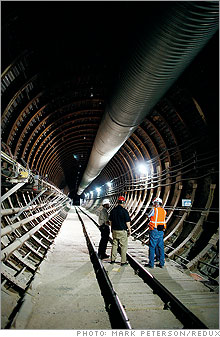(Fortune) -- The drive to the proposed Yucca Mountain nuclear waste repository from the Energy Department's office in Las Vegas takes about two hours. It's a freaky ride, past fast-growing Pahrump, Nevada, now a bedroom community for Las Vegas; past Nellis Air Force base, where unmanned spy drones -- Predators and Raptors -- fly test flights; past the gunnery range and the old atom bomb test site.
Next I'm within spyglass range of Area 51 (you know, where the government stores aliens in giant freezers), then headed through Lathrop Wells, the last inhabited outpost on the way to Yucca, with two gas stations and a brothel; to the perimeter guard house, and we're in.
 |
| Inside Yucca Mountain |
The industry is gearing up to build its first new plants in decades.
How bad was the accident really?
The industry is coming alive in the Midwest's Ohio Valley.
Will power companies foot the bill?
It's not easy building a home for spent radioactive material.
An Idaho lab is at work on next generation reactors that promise to deliver more reliable energy.
Mike Voegele, former chief scientist at Yucca Mountain, now retired, points out landmarks on the barren, toasted landscape -- remnants of the other uses this desolate patch of desert has endured in years past. The surplus missile silos left over from the Cold War, for instance, are unearthed now and lying on their sides and converted into offices.
And Little Skull Mountain, away on the northern horizon, is the site of what Voegele describes as "my personal favorite test done in the whole United States." It was there that the Air Force once stood a tunnel boring machine on its end and buried it under 50 feet of broken rock, simulating conditions that would result if the Russians bombed us before we could bomb them.
"The ballistic missile office wanted to know, even if we were all dead, if the machines could wake up and fire back a retaliatory strike," says Voegele. "They demonstrated that you could excavate a vertical hole inside of a mountain and get [a missile] out through the broken rock. The boring machine is still sitting up there, with an Air Force flag painted on it."
We peek inside the five-mile tunnel they finished drilling 10 years ago. But it's just a tunnel; not much to see. Yucca Mountain has been under development for more than three decades. If it ever opens -- and that won't be until 2017, at the earliest -- 77,000 tons of nuclear waste will one day travel through this tunnel to their final resting places 1,000 feet below the ridgeline of the Mountain. But that's a big if. Construction has been stalled since 1997, pending regulatory approval. The outlook is bleak.
The highlight of the trip is the visit to the top of Yucca Mountain. Up a steep and winding gravel road, really just a shaving on the crust of the mountain. The driver struggling to stay on course. Some slippage in the steepest parts. No guard rails, of course. Help me remember: Did the safety officer cover situations in which the tour bus goes tumbling into the abyss?
Death Valley views
Finally, we arrive. Very windy at the top. Desolate and strange. Big views west across the desert floor to California and Death Valley. We all stand around for a few minutes, contemplating eternity, or at least the next 10,000 years. This place was chosen as our nation's nuclear waste repository in large part because no one lives anywhere near here, and likely no one ever will; this place will never change. Freaky thought. Then it's time to go.
The conversation among the engineers on the long ride back to town turns to water, of all things. There's not nearly enough of it in Las Vegas. But there are all kinds of crazy of schemes floating around. Schemes that to their ears have even less chance of ever being realized than Yucca Mountain does.
"There's a group of people saying you could build a pipeline from rural Nevada north of Las Vegas to the California coast, about 230 miles," says Richard Tosetti. "Pump in the saltwater, build a nuclear plant, desalinate the water while you cool it at the plant and then pump that fresh water to Vegas. There's a group out there putting together a plan!"
Tosetti's laughing hard now, and so is Voegele. These two, jaded from long experience, know what its like to confront horrendous engineering and regulatory obstacles for decades; they have a pretty good idea what the proponents of this crazy water project are up against. "I'll tell you," says Tosetti, once he finally stops laughing. "I'll take my chances on this job."
Email: dwhitford@fortunemail.com 